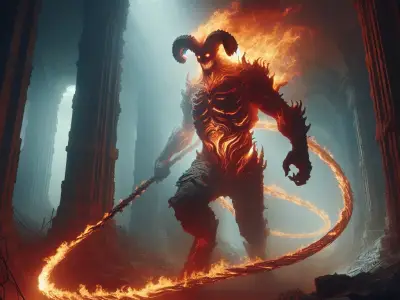From Bigfoot to Mothman – cryptids are the creatures that crept into your childhood nightmares. For most, cryptids remain the stuff of myth and legend, relegated to things that go ‘bump’ in the dark. However, some cryptozoologists have dedicated their lives to investigating these myths, where they come from, the veracity of sightings, the social phenomenon associated with cryptids and the desire to capture and understand these strange monsters.

Friend or Foe? Ferocious Cryptids
- Mapinguari
- Mothman
- Kraken
- Megalodon
- El Chupacabra
In South American folklore, people still share tales of the Mapinguari. This most creepy of cryptids is said to be a giant, sloth-like creature with red fur, one eye, long claws and even a mouth in the middle of its stomach. The Mapinguari, in described sightings, was shrouded in a fetid smell from which it gets its name, ‘fetid beast’. Most cryptozoologists consider this creature to be a relative of the giant sloth of a megatherium, a long-extinct elephant-sized ground sloth dating back to the Ice Age.
Mothman is unique in this list, in that this legend doesn’t originate from sightings of terrestrial species. Rather, this most peculiar of the cryptids is shrouded in the supernatural. The myth began with five gravediggers in West Virginia in the 1960s who reportedly sighted a giant man with sprawling wings flying among the trees. This creature was dubbed Mothman by the local press and further sightings were subsequently reported by terrified onlookers who claimed, among other horrors, that its eyes glowed red and it could fly at speeds of 100mph. The community in the village of Point Pleasent was rattled and began associating the Mothman with the disappearance of dogs and other strange happenings for over a year, and even a bridge collapse in December 1967 that killed 46 people — either directly blaming the alien being or claiming it was, at the very least, a harbinger of doom. The Mothman wasn’t seen in Point Pleasent after the Silver Bridge collapsed. But it has since been spotted by onlookers who witnessed other catastrophes such as the 9/11 terror attacks, the Freiburg mine collapse, Chernobyl, Mexican Swine Flu, and Fukushima.

Scientists have explained the sightings by pointing to the Mothman’s description as resembling that of a sandhill crane. Others say the initial sightings could simply have been pranks that became embedded into folklore and thus caused the other believed sightings at times of great confusion, loss and tragedy.
Beware the Kraken, sailors say! And considering the sea beast’s plentiful tentacles, its habit of taking down ships, and the stench of its breath clouded with the rotting flesh of its victims that signifies death is close by, you can hardly blame them! The Kraken was first referenced in the 13th century in Norse folklore but has since entered popular discourse with many suggesting the myths of this mile-wide cephalopod were instigated by fearful seamen who had, in fact, spied a giant squid as they traversed new and other-worldly waters on sea expeditions. The Kraken has certainly been released beyond the murky world of cryptozoology and into the mainstream.

Now, to more cryptids of the deep sea. The Megalodon is the largest shark to have ever swum the oceans. An extinct species of mackerel shark, it has been proven to have lived approximately 23 to 3.6 million years ago. Scientists say the creature is long extinct but cryptozoologists can still be found hunting for one of these so-called cryptids. The name Megalodon means ‘big tooth’. With big teeth, come tales of an insatiable predator. Megalodon measured up to 50-feet in length and fed on whales. Their massive and fossilised teeth can still be found on the sea bed off the east coast of North America.
Meet El Chupacabra. While other cryptids have a long historical place in folklore, this cryptid of South America has had a short, but terrifying, impact on the farming communities of Puerto Rico since the 1990s. Its name means ‘goat sucker’. The initial reports and sightings came at a time when farmers were waking in the morning to find their goats and sheep dead, their uneaten carcasses completely drained of blood with three puncture wounds in their necks. Over the coming months in one small town named Canovanas, hundreds of animals including cows, pigs, chickens and even domestic pets were slaughtered in this way as more and more locals reported seeing a bipedal scaly-looking creature with spikes down its back and massive claws roaming the night.

Enter the cryptozoologists. Namely, Benjamin Radford, who spent five years investigating El Chupacabra. It was hypothesised that the slaughters had been largely by wild dogs and coyote hybrids whose horrific skin appearance was caused by widespread sarcoptic mange.
On the Hunt for Cryptids
So, with some scientific evidence to combat the theories of these cryptids put forward by cryptozoologists, and little conclusive evidence of the existence of the likes of the Loch Ness Monster or Bigfoot, what is left for our cryptids and their followers? Well, even though funding is often hard to come by, the believers’ searches continue. And, it seems, with the boom of crypto tourism and the popularity of discussions surrounding cryptids in mainstream media, if you are a believer, you are not alone.
At the time of publishing, entering the code LEARNING in the checkout will reduce the price of our
Cryptozoology Diploma Course to £29.





